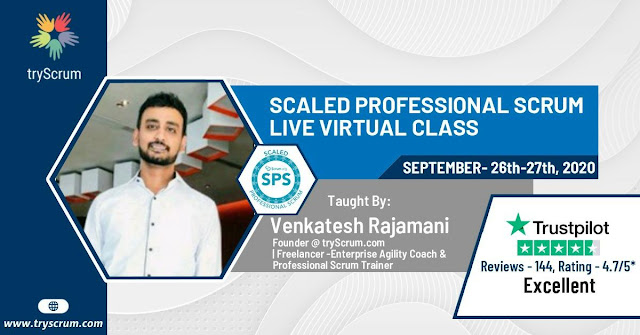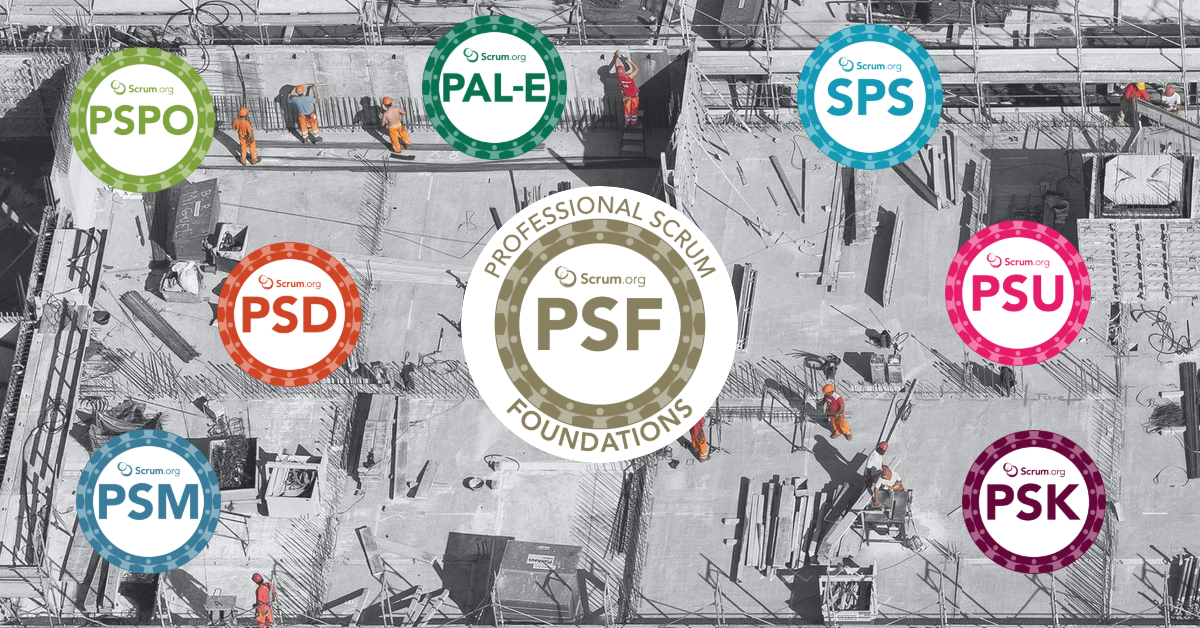The
Scrum Framework is a lightweight framework to solve complex and adaptive
problems with others. Although it looks easy on paper, it’s often much harder
to do well in the messiness of the real world. Where do you make trade-offs?
How can you model the Scrum values? How can you work empirically in an
environment that isn’t suited for it?
To encourage Scrum practitioners to explore these questions during professional scrum master training at tryScrum, we created 52 real-life cases. These cases are inspired by our own experiences and those of the people we frequently work with. Use these cases for your community of Scrum Masters, as conversation starters in and around your Scrum Team, or put your own understanding of Scrum to the test. And no, there is no “right answer” :) The learning is not in knowing the answer, but in jointly deepening your understanding of the Scrum principles and values through reflection, dialogue, and putting new ideas into practice.
The
deck is provided as a digital download with 52 cases for a small fee. We also
have a free version available that includes 10 cases. In this blog post, we
offer inspiration for when to use these cases and give suggestions for what
Liberating Structures to try as conversation starters.
Example
of the case: “What are good metrics?”
When
to use the cases?
Finding
a good opportunity to use the Scrum cases shouldn’t be too difficult. You can
use them for individual reflection, within your Scrum Team, or the wider
organization. Some specific examples to use the Scrum cases are:
During
Sprint Retrospective. Share the Scrum cases before the Sprint Retrospective
with your Scrum Team. Ask everyone to select the cases they think are the most
interesting, relevant, or challenging. Identify the top-3 and bring those cases
to the Sprint Retrospective to discuss in more detail.
For individual reflection. Select a Scrum case, get your own thinking started, and share your thoughts on LinkedIn. Most likely, it will trigger a conversation in which you can explore the case with other Scrum practitioners.
Within
your Community of Practice. Many organizations have a Community of Practice in
which participants share experiences and give & get help. Organize a
session with the most relevant Scrum cases as a topic. Also, you can learn vast
knowledge about product owner certification
online.
As
a conversation starter with management. Share the Scrum cases with management
in your organization. Ask them to identify the most challenging cases or the
one that raises the most questions. Simply have a one-on-one conversation with
a manager about a specific case. Or host a workshop with more managers to
discuss the cases.
During
a public meetup. Make a specific Scrum case the topic for a public meetup. For
example, your local Scrum user group. The wide variety of experiences will
offer many different, fresh, and surprising perspectives.
For
a job interview. Use the cases for any kind of Scrum related job interview.
Prepare a couple of cases, ask the candidate to select the one (s)he considers
the most interesting, challenging, or recognizable and simply have a conversation.
By discussing the case you’ll get a good sense about the person’s understanding
of the Scrum Framework.
Example
of the case: “The technical Sprint Review”
How
to use the cases?
We
purposefully wrote each case in such a way that there is no clear “right”
answer. Instead, there are different sides to each case, different arguments to
make, and different solutions — some better than others. Just like the real
world …
For
the best learning experience, use Liberating Structures to structure the
conversation. That way, everyone can offer their perspective. You may even find
creative solutions to your own challenges!
 |
Some
examples of Liberating Structures to try are:
Conversation
Cafe. We like to use Conversation Cafe to dig into cases like these. It
encourages people to listen and understand each other’s perspectives on a
profound, shared topic or challenge instead of trying to convince or persuade
others to see it your way. Sitting in a circle with a simple set of agreements
and a talking object, small groups engage in consecutive rounds of dialogue.
Follow-up with 15% Solutions or 1–2–4-ALL to translate learnings from the case
to your own team or environment.
1–2–4-ALL.
Only doing a 1–2–4-ALL during a session is already a good approach to explore a
case. Start with 1 minute of silent self-reflection. Take 2 minutes to generate
ideas in pairs, building on ideas from self-reflection. Create groups of four
and use 4 minutes to share and develop ideas that you’ve discussed within your
pair. Notice similarities and differences. Take 5 minutes to share insights,
ideas, and takeaways.
Impromptu Networking. With Impromptu Networking, you can discuss a case within 15 minutes. Invite the participants to stand up and form pairs. Present the case to discuss. Within the pairs, ask people to share their answers to the case. Signal the end of the first round and have people from new pairs. Within the new pairs, ask people to (again) share their answers. But also ask them to pay attention to similarities and differences from their previous conversation. Do one rounder. After the 3 rounds, gather insights and patterns that the participants noticed.
User
Experience Fishbowl. The UX Fishbowl is ideally suited for unleashing the local
wisdom of groups of any size. If within your team or organization people have
experience (successes or failures) with a certain case, invite them to
participate as the “inner circle” of the fishbowl. During the UX Fishbowl, the
inner circle shares experiences while the outer circles listen. In alternating
rounds, the outer circles generate questions they’d like to ask the inner
circle. By focusing strongly on listening and asking questions about
experiences, you can use UX Fishbowls to create an environment where people can
learn together (rather than get solutions imposed on them).
Conversation
Cafe in a workshop with Swisscom and KPN iTV. Conversation Cafe is a great
Liberating Structure to explore the cases.
Discovery
& Action Dialogue. “Discovery & Action Dialogue” (DAD) exists to help
groups invent local solutions to the problems they face. Rather than giving up
or immediately reaching to “best practices” that worked elsewhere, it helps
groups carefully analyze the problem, potential solution, and how everyone can
contribute to both. To use “Discovery & Action Dialogue”, select the most
challenging case for your team or organization, download this worksheet, and
discuss the questions in small groups.
Wicked
Questions. Especially because there are no right answers, the Liberating
Structure Wicked Questions is ideally suited to discuss the cases. The purpose
of Wicked Questions is not to find a single answer, but to create transparency
about seemingly paradoxical realities that exist side-by-side. By accepting
both realities, you can engage in deeper strategic thinking and explore new
possibilities for the “Wicked Cases” at hand.
Integrated
Autonomy. Most of the challenges we face in the real world don’t have an easy
answer. Different solutions can be true or happen at the same time. This is
also reflected in the 52 Scrum Master cases where multiple answers might be
true. When discussing the cases, it’s tempting to get stuck in
either/or-thinking. But what would happen when we start thinking in terms of
‘and’ instead of ‘or’? What if we can find solutions that are helpful to both
sides? Integrated Autonomy will help you adopt a more holistic view of the
cases. Instead of steering the group in one direction of possible solutions, it
actively invites them to uncover solutions that work across the field.
Wicked
Questions combined with Discovery and Action Dialogue and Integrated Autonomy.
A string we used during the Immersion Workshop in May 2019 in Amsterdam. The
visualization is created by Thea Schukken.
Shift
& Share. Especially in larger groups, Shift & Share is an ideal
structure to discuss one or multiple cases. Prepare 4–6 stations with each a
specific case. Ask the group to form small teams and to pick one station. At
their station, the teams discuss the case and write feedback on the flip-over.
After 10 minutes, the teams move clockwise to the next station. This is
repeated until the teams have visited all stations. Discuss the key-takeaways
with the group as a whole.
Improve
Prototyping. The purpose of Improve Prototyping is to re-enact a challenging
scenario (e.g. Scrum case) faced by a group or an individual and work together
to devise different behavioral strategies and interventions by acting it out.
The twist that this structure brings is that the person who introduced the scenario
becomes the ‘director’, while the others become the ‘actors’. This allows the
director to playfully experiment with strategies, behaviors, and interventions.
As such, Improve Prototyping is ideally suited to explore the Scrum cases!
What,
So What, Now What? ‘What, So What, Now What’ is a foundational Liberating
Structures that helps by asking us to step back and consider what is going on.
It structures our thinking by breaking our experience down into three steps:
“What do we notice?”, “So, what does this mean?” and “Now, where do go from
here?”. The flow of this Liberating Structure makes it ideally suited to
reflect on the Scrum cases. Considering using 1–2–4-ALL to answer the
questions. This prevents a group discussion and allows everyone to reflect and
contribute.
Example
of the case: “The part-time Scrum Master”
Closing
words
In this blog post, we offered inspiration for when & how to use the 52 Scrum cases we created for the Scrum community. We hope it will trigger valuable conversations in and around your Scrum Team, improve your understanding of the Scrum Framework, and grow a stronger Scrum community. The 52 cases are available as a digital download for a small fee. We also have a free version available that includes 10 cases. Enjoy using them!
Want
to learn more about Scrum and how to become a more effective Scrum Master? Join
our on-site Scrum.org Professional Scrum Master II course or the online
edition. We guarantee a unique, eye-opening experience that is 100% free of
PowerPoint, highly interactive, and serious-but-fun. If you need help, feel
free to join our user group ‘The Liberators Network’, which is all about
learning and growing, together!
Resource:
https://www.scrum.org/resources/blog/52-challenging-cases-scrum-practitioners





















